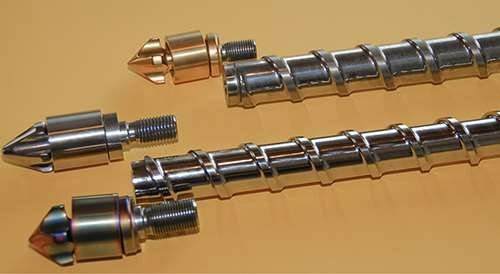Table of Contents
Plastic injection molding (PIM) is a process for producing parts. One vital part used in this process is a reciprocating screw.
A reciprocating screw is a part of the injection molding machine that is used to feed the plastic resin into the machine. It allows for a predetermined amount of material to be injected into the press.
A reciprocating screw includes:
– A cylinder (barrel) which can vary in size and geometry; it has end plates for mounting flanges and gates, runners, or sprues.
– A screw which is made up of a shaft with flights and thread profiles, for conveying the material forward through the barrel. The screw type will depend on various factors, including flow rate requirements, material characteristics, wall thickness requirements, etc.
– An end plate (typically two) as well as flanges to connect it to the outside world.
– Two end plates (typically one on each end of the barrel) that are machined with bolt holes for mounting all components.
– A shaft that contains flights and thread profiles to force the material forward through the barrel.
What is a PIM reciprocating screw and what are its uses?
A reciprocating screw is a type of gas compressor that moves an air chamber back and forth using the piston to compress or evacuate air. One side pushes compressed air into storage while simultaneously pulling in external atmospheric pressure, then pushing out the pressurized air again. The “plunger rod assembly” of the reciprocating screw helps move this process forward by driving up and down to compress or evacuate air.
How does a reciprocating screw perform compared to other gas compression machines?
A reciprocating screw is quieter, less expensive, and more energy efficient than other gas compression machines like rotary screw compressors. They are ideal for areas where noise can be an issue, such as residential zones or industrial settings. Many use frequency inverters to provide power savings and greater control over the speed of the machine at different phases of operation.
What are some other characteristics of a reciprocating screw?
A reciprocating screw has minimal oil in its system, which reduces risk of hazardous materials. It also distributes refrigerants more evenly throughout the machine, which reduces harmful thermal stress on components.
What are some reasons to invest in a reciprocating screw for my business?
Reciprocating screws provide superior performance over other compression processes, especially when it comes to emissions. It runs at higher pressure with lower emissions of nitrogen oxide and has no evaporative emissions. This will keep your business running efficiently and legally.
Is it better to use this process of compression than other methods?
Yes, because reciprocating screws are always more efficient than rotary screws or turbo-compressors (and also less expensive). The process even maintains this efficiency at high altitudes (“up to 3,000 m” (9,842.50 ft)).
With a reciprocating screw, you can use natural gas to power the compression instead of more polluting diesel fuel.
Why is this process so efficient?
A reciprocating screw system uses a fixed-volume expansion chamber with a piston driven by a crankshaft and camshaft mechanism. The piston’s design allows it to withstand extreme compression pressures. It can be installed both horizontally and vertically.
When compared to rotary screws, reciprocating screw compressors are smaller and use less compressed air. This allows them to reach higher compression ratios, which saves you energy. A high compression ratio also means your unit can handle higher volumes of compressed air.
A reciprocating screw compressor is very easy to start, requires no lubrication, and requires very little maintenance. Because it uses a rotating piston, there is virtually no wear on its components or seals. It’s also quiet, which makes it ideal for many applications where noise must be minimized.
What industries are most likely to use PIM reciprocating screws and why do they find them helpful for their needs?
PIM reciprocating screw compressors can be found in a variety of different industries.
Manufacturing plants use them to power machines and tools that require compressed air, like sandblasters and paint booths. They’re also used in places like manufacturing facilities and offices where large volumes of compressed air are needed for pneumatic devices, such as nail guns, air diaphragm pumps, and spray painting equipment.
Are there any potential drawbacks to using PIM reciprocating screws?
PIM reciprocating screws are often used in places where there is a high risk for fire to form, as they use pressurized gas to power the compressor. If oil isn’t properly filtered or lubricated, then it can combust and cause an explosion. The compressed air that PIM reciprocating screw compressors produce may also contain water vapor, which can freeze in the piping when high pressures are released. This can be minimized by using expansion valves.
Another drawback to PIM reciprocating screws is their large size compared to other types of compressors.
Conclusion
PIM reciprocating screws are a useful type of compressor in certain industries, and they have many advantages. They have a higher pressure ratio than other forms of gas compressor. However, they have some drawbacks that should be considered before use.
Thanks for reading!








